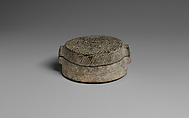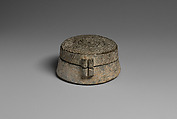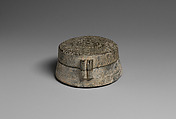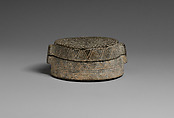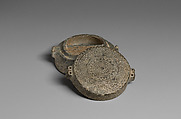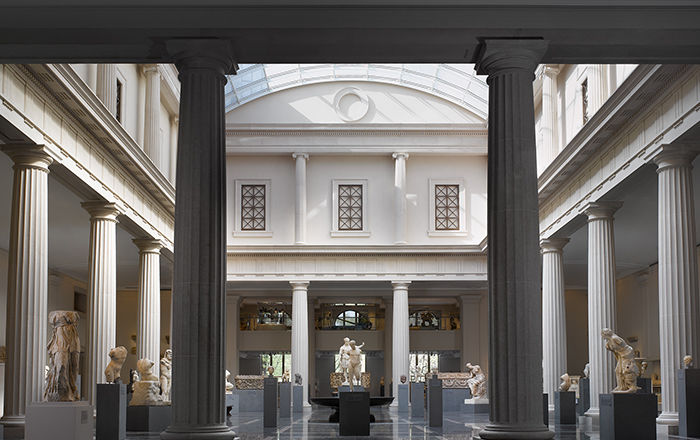On loan to The Met The Met accepts temporary loans of art both for short-term exhibitions and for long-term display in its galleries.
Chlorite pyxis (box)
Technical Analysis: Ultraviolet-induced visible luminescence examination, optical microscopy, Raman spectroscopy, micro-X-ray diffraction
This lidded stone box, known as a “hut” pyxis, is complete with only minor losses at the outer edges and a hole in one of the lugs. It was carved from a single block of greenish-grey, massive chlorite and is incised with an elaborate decoration rendered by hand. The nearly cylindrical vessel and its matching lid have aligned, double tubular lugs pierced for threading a thin rope that would fix the lid to the container. A carinated ridge around the interior of the vessel fits and helps secure the lid. A partition wall across the interior divides it into two unequal compartments.
Two concentric bands of hatched and plain triangles separated by three concentric lines decorated the exterior body. Another band of hatched and plain triangles embellishes the vertical walls of the lid. On the flat top of the lid are concentric bands of various decorations: a plain circle at center, followed by one with oblique lines, another with hatched and plain triangles, a running double spiral and, on the edge, a zigzag pattern. Kaolin, a pure white clay, may have been used to fill the incisions and accentuate the designs.
This type of vessel is discussed by Getz-Gentle.(1) Another such vessel is in Berlin Antikensammlung Staatliche Museen, inv. no. 8102, from Amorgos, Dhokathismata acquired by Duemmler in 1889. Similar fragments come from special deposits at Keros Kavos.(2)
There are beige accretions noticeable in the incised decoration. Reddish hematite accretions on the lid relate to burial. In addition to minor losses at the outer edges and one of lid lugs, there are scattered, more recent, abrasions, scrapes and scratches. The upper and outer edges of the pyxis are shiny and darker in coloration from handling.
Georgios Gavalas, Linda Borsch, and Federico Caro
(1) See Getz-Gentle, Pat. 19996, The Stone Vessels of the Cyclades in the Early Bronze Age. pp.192-204, pls. 107-114, University Park: The Pennsylvania State University Press; This particular vessel is mentioned and illustrated without any further details on pp. 192-193, 351, pls. 108e, and 109d, and its closest parallel is illustrated on p. 351, pl. 109c.
(2) See Gavalas, Giorgos. 2018. “The Stone Vessels”, in Renfrew, Colin, Olga Philaniotou, Neil Brodie, Giorgoso Gavalas and Michael J. Boyd, eds. 2018. The Marble finds from Kavos and the Archaeology of Ritual, The sanctuary on Keros and the origins of Aegean ritual practice, the excavation of 2006-2008, Vol. III. pp. 327-332, figs. 4.53-54 and 4.59, Cambridge: McDonald Institute for Archaeological Research, University of Cambridge.
This image cannot be enlarged, viewed at full screen, or downloaded.
This artwork is meant to be viewed from right to left. Scroll left to view more.


